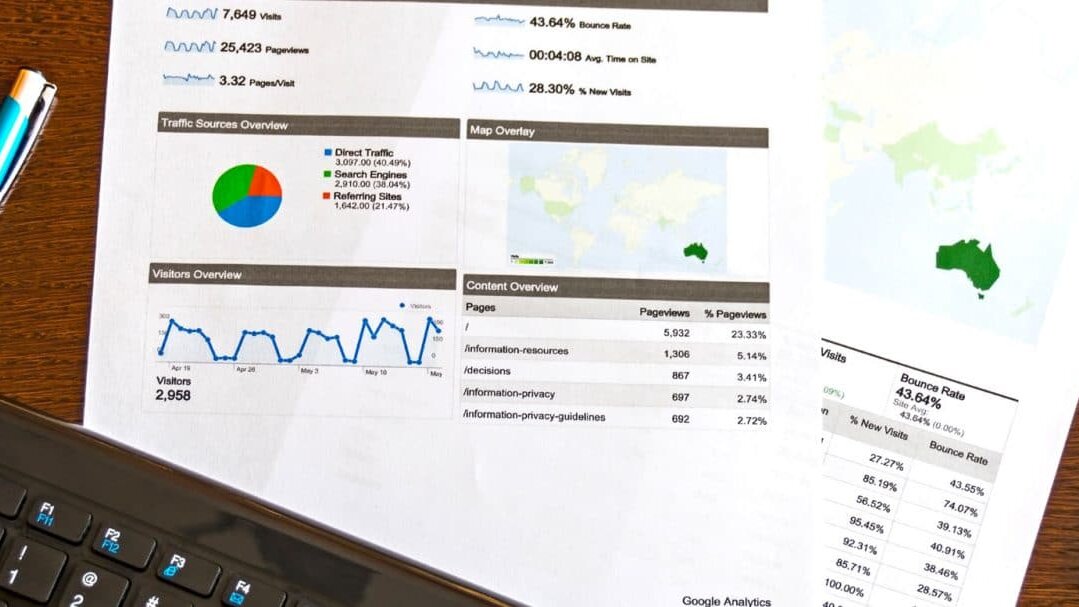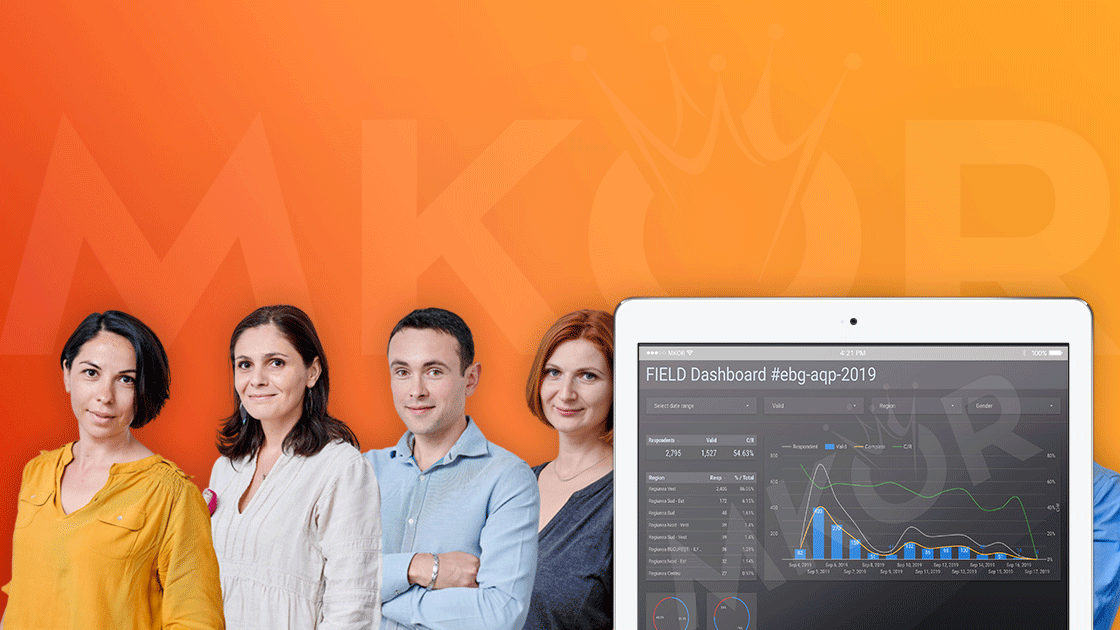To learn how to do market research in a professional way, it is important to first know what a market research is.
Having set the objectives from the start, the information will be easier to follow. Go through the expert guide for a detailed explanation.
This article is divided into 3 parts, and was modified in 2024 to present up-to-date information.
Content part 1
What is a Market Study?
Whether you call it Marketing Research, Market Research, Opinion Polling, or Market Research, a market study is a subfield of Marketing that deals with market knowledge and prospecting.
The main means used in Market Research are the collection, centralization, analysis and interpretation of market data relating to customers, competitors, market sizes, products and services.
In other words, through research we look carefully at what is happening in the market : what are the needs of consumers, what do the competitors look like, what opportunities and what trends are there.
Why should you do market research in 2024?
Through its objectives, market research provides a strategic advance over competitors. It can significantly contribute to the success rate when designing a product. With the help of market research, products and services can be launched, tested and improved.
Based on the collected information, informed decisions can be made and, thus, the risks are reduced.
Market research analyzes the behavior, attitude and opinions of the target audience. This facilitates the definition and planning of other aspects related to Marketing:
- promotion,
- brand evaluation,
- e-marketing,
- business plan.
With the help of a market study, a marketing strategy appropriate to the market can be implemented in a well-defined context.
A market study captures aspects regarding:
- Vital Information. Market research can provide extremely important information about the needs and size of the market, as well as the competition.
- Final consumers. You will find out the wishes, needs and opinions of end consumers. Thus, you will know them better and know how to act, to offer them the services and products they need.
- Marketing optimization. A market study can be used to determine how a product or service can be promoted. Peter Drucker considered research to be the quintessence of marketing, and we exist because we think he’s right!
- Demand and supply. Research can help you adjust your production volumes based on market demand and needs, so you don’t lose important company resources. It will also help you establish sales forecasts as realistically as possible, establishing a correlation between demand and supply for the products or services you offer.
- Supply chain optimization. A well-done market study can help you optimize the stages of the processes by which you deliver goods or services to customers. You will understand the efficiency of current distribution methods and can provide you with information about the best methods to deliver your products or services to your customers.
- Efficiency of promotion channels. Research will help you weigh how effective different media channels you want to use for your advertising campaigns are based on your message and target audience.
- Reputation. A market research will give you information from the market regarding the reputation of the company or the products.
- Satisfaction. A market study can determine the level of satisfaction of your customers, regardless of whether you are addressing end consumers (B2C) or business customers (B2B).
- Legislative topic. Market research can help you understand how different legislative restrictions and limitations, in your country or at European level, can impact your business.
- Pricing policy. Market research will help you correctly determine the price ranges for your company’s products and goods. It can also help you determine the discounts to offer to partners and customers.
- The competition. The market study helps you to know the marketing strategies and prices of the competitors in the market you are active in.
- New opportunities. A market study can help you discover new markets for your company’s products and services.
When to do Market Research?
- When you want to estimate the market potential for a new product or service you want to launch.
- When you want to find out consumer reactions to an already existing product or service.
- To find out general market conditions and trends.
- To find out the reasons why an existing product is not selling.
- To find better methods of distributing products and services to consumers.
- To know the types of consumers who buy a particular product, the reasons why they buy and their suggestions to improve that product.
- To assess competitors’ strengths and weaknesses.
- To estimate the company’s market share.
- To estimate sales volumes.
- To assess consumer reaction to the packaging of the company’s products and to make them as attractive as possible.
- For market segmentation, in the sense of dividing the population with similar motivations, according to predefined criteria (psychographic, demographic, geographical or according to the use of the product).
What is the first step? General Market Analysis
When we start a market research, it is important to define its objectives. Usually, the business has a need or an opportunity has been identified in the market, but there is not enough data to make a decision. So, having the problem exposed from the beginning we will be able to focus on the effectiveness of the research.
To determine the profile of the market of interest, it is advisable to take into account: the number and size of producers and consumers in the market, the types of goods and services that are traded and the degree to which information can spread. This information can be obtained by means of a certain type of market study, namely the sectoral one.
Sector Study
The Sector Study focuses on a specific market sector and provides data on the players in the market, the size and potential of the market’s consumers. Completing this stage will help you easily adapt to your desired market and respond according to consumer needs.
The Sector Study will help you determine the profile of the market in which you operate or wish to operate and to what extent your business objectives correspond to the market.
Sector Study – Benchmarking
An important component of the Sector Study is Benchmarking through which you can find out which are the best performing practices in the industry, which can later become support for improving your own processes. Benchmarking allows you to compare with other companies in terms of quality, time and costs to ultimately optimize your efficiency.
Benchmarking involves identifying the best companies in the field and comparing their results to your company’s. This will help you understand your business and, most importantly, understand what makes those companies successful.
Sector Study – PESTLE Analysis
PESTLE is an effective tool and a comprehensive concept in market analysis. This tool helps you get an overall view of market conditions. When you have an idea to implement, you have to do it strategically, taking into account independent variables.
The PESTLE analysis describes the impact that a series of influencing factors have on strategies, resources and organizational culture. PESTLE is an acronym obtained from the English language through mnemonics :
P for Political E for Economic S for Social T for Technological L for Legal E for Ecological (Environmental).
By taking these variables into account, the chance of success of your business plan increases significantly because you prevent possible penalties for, say, not knowing the legislation in a certain industry.
So, in a PESTLE analysis, answers to a series of questions are sought :
- What is the political situation in a country and how is it affecting the industry I am interested in?
- What economic factors are present?
- How important are cultural factors and who defines them?
- What technological inventions may emerge and influence the market?
- Are there legal regulations for the industry I am interested in? Are there any legislative changes in the future?
- What environmental concerns are there?
An explanation follows for each issue addressed.
1. Political influencing factors
The analysis considers political decisions that can influence the economy as a whole or a certain market.
For example, a lack of understanding at the level of the political class regarding the importance of spatial planning and the specific problems facing local industry can lead to stagnation.
Other factors to consider:
- fEES
- fiscal policy
- commercial rates or
- fiscal year.
2. Economic influencing factors
The pressure of economic interests and their prevalence over your business can have long-term effects.
For example, the increase in the inflation rate determines the pricing policy of products and services. Factors considered: inflation rate, interest rate, exchange rate or level of foreign investment.
3. Social influencing factors
Elements of social structure and demographics are important to the success of any business. They describe the cultural climate of the market and with their help cultural trends can be determined.
For example, in Japan all mobile phones are waterproof, something that is hard to ignore for someone aiming to enter this market. Moreover, local holidays can be profitable for certain industries, as March 8 is for florists in Romania.
Technological influencing factors
For many industries, technological factors are extremely important. Technological innovations can affect a company’s operations negatively or positively. New technologies such as those that reduce pollution, improve competitiveness and reduce energy consumption are relevant for a company.
For example, the appearance of a technology that automates work for a company translates into cost reduction.
4. Legal influencing factors
The factors that are taken into account are legislation, legal and institutional regulations. An analysis of the legal system is essential to avoid its violation and possible sanctions.
The most relevant legislations are those regarding the safety of consumers or workers.
5. Ecological influencing factors
Any economic activity has an influence on the environment. Environmental care elements analyzed include climate, weather, geography and global climate change.
For example, emergency management takes into account the conditions for aggravating the effects of natural disasters (floods, landslides, earthquakes) and ways of prevention. So, the PESTLE analysis is the framework on which you build your business idea implementation plan. This type of analysis comes in handy for both multinationals looking to expand into a new and unknown market, as well as local companies looking to meet industry standards.
The potential of the Market
As part of a study, assessing the market potential is vital to understanding the opportunities in the market. Ultimately, the success of a product or service depends on the size of the market. The potential market represents the possible dimensions of the market, the limits within which the demand is contained.
The market consists of existing or potential customers with purchasing power and unmet needs. Starting from this data, market potential involves determining to what extent the product or service will satisfy the needs of customers in a certain area, at a given time, and to what extent they have purchasing power.
When analyzing market potential, specialists look to see how the market will evolve in the short, medium and long term, who potential customers are and where they can be found, what price customers are willing to pay and how much interest there is in launching a product or service.
Forecasting is a technique that makes financial projections to anticipate the quantities of products or services that will be purchased by customers in a defined time. The sales forecast differs from one target segment to another, taking into account the absorption potential, the competitive situation and the market position of its own offer.
Basically, sales forecasting is estimating future turnover based on likely sales volume. Furthermore, market potential considers market share, i.e. the actual or potential share of a product at a given time. In other words, it measures how many of the market consumers of a product return to the company.
The location or market area is the delimitation of the territory where the company operates.
According to the place where the buying and selling process takes place, the market can be:
- internal (national);
- external (international);
- worldwide (both domestic and international).
Finally, the market potential study will provide information on the number of potential customers, the number of purchases made by them, the frequency of purchase and the growth potential of the market.
Trends and Tendencies
Trend is the key element in technical analysis having the ability to indicate the direction of the market at a given time. By following the direction of the market, you can exploit opportunities and anticipate customer needs.
Customers will tell you everything you need to know about them, the important thing is to know where to look. Most of the time, that means looking everywhere. In this regard, opinion polling comes to the rescue with methods and tools for data collection and interpretation.
Trends are important because they indicate the directions of production or consumption. In the market there are always companies that take the initiative and create trends among consumers. That’s why it’s important to know your competitors’ approaches.
A market study allows you to find out what the trends are and how you can align with them or, why not, how to set the tone for some new ones yourself. Price is no longer a deciding factor in choosing one brand or another.
The customer experience matters more and more, and the interaction with the brand weighs in the final decision. Customers turn to companies that have the ability to meet their needs not only to high standards, but also in a pleasant way.
Some trends are specific to a certain industry, while other trends have broad applicability.
For example, online trends are important for small and large companies, because online presence has turned from a trend into a must. However, a simple website is not enough because the Internet evolves at a dizzying speed.
Given the fact that we live in an increasingly digitized and connected world, it is important for a company to be relevant in search engines, to be present on social media platforms and to be attentive to the trends of the virtual world.
Companies that understand and pay attention to these trends on a regular basis are the ones that experience the most success in the campaigns they launch.
A market study will capture trends and trends to help you track and stay on trend so that you become a viable option for customers.
Competitor Analysis, Porter’s 5 Forces
A multitude of tools are used in competitor analysis, and one of the most comprehensive was developed by Michael Porter.
Porter’s 5 Forces form a framework for understanding the forces of competition in a given market and how the value created is shared among these actors.
In other words, the five forces model indicates the intensity of competition in an industry. Such an analysis is important to know how to position yourself in the market.
A market research that takes into account Porter’s 5 forces, helps you understand which forces affect the evolution of the company and which factors can present a danger to the competitive advantage you have.
In this sense, it is recommended to know the dynamics of the market you operate in order to maintain your relevance and competitiveness.
Porter’s analysis helps to understand the strengths and the current position in relation to the competition. Moreover, the analysis highlights the opportunities, the competitive advantage that the company can take advantage of.
The weak points are also identified to come up with an improvement on them. The overview that the analysis provides can help you avoid wrong steps in the development of the company.
The competitive environment is structured on a number of five forces that generate and control the competitive state between the organizations that form the external competitive environment. According to the model proposed by Michael E. Porter (1980), the five forces of competition are:
- 1. Rivalry between players;
- 2. Threat of new players;
- 3. Threat of substitute products;
- 4. Buyers ‘ bargaining power ;
- 5. Bargaining power of suppliers.
1. Rivalry between players
Competitive analysis reveals how the value created is distributed in the market. A market with little rivalry is attractive, which increases competitors’ profits.
In the analysis of rivalry between players, it is important to define the market according to the number of existing competitors, the elements of differentiation between them, the market trend, the attitude of the players (whether they are aggressive or not) and the territorial dispersion.
Furthermore, the means used by competitors on the market are identified: competition on price, competition on variety and style of products, advertising campaigns and promotions.
Going through these steps will help you understand the level of rivalry between players.
2. Threat of new players
In the market a threat is also the potential competition, not only the existing one. The threat of new players is directly proportional to the barriers to entry in the interest market.
If entry costs are high, for example the initial investment in technology, then this will restrict a new player’s ability to enter.
3. Threat of substitute products
Substitute products are a threat when the customer decides that a product other than the one you sell can satisfy their needs.
The intensity of this threat increases when a more attractive offer in terms of value for money appears.
For example, postal services have been replaced by email or other products can simply be given up (cigarettes).
4. Bargaining Power of Buyers
Customers can use their power to demand lower prices, better service for the same price.
The power of buyers is high when they are more numerous compared to those who satisfy their needs, when there are no price differences between products, so they do not feel the switch from one brand to another. The bargaining power of customers is determined by their size and concentration.
5. Bargaining power of suppliers
Powerful suppliers can influence their price increases or negotiate favorable agreements with competitors, which lowers industry profitability.
If, for example, there are only two suppliers in the market for an important material, or if switching suppliers involves high costs, then one of the suppliers has more power.
The bargaining power of suppliers is high when there are few suppliers and many customers in the market.
The importance of market contextualization
Figures, on their own, aren’t much help without context. Context is the difference between delivering insights or delivering market research.
A brief history of the industry of interest or a description of the market gives meaning and legibility. In order to serve it as well as possible, it is important to understand your target market in depth.
A deskresearch on the analyzed market will provide information that will coagulate the entire marketing study. Delineating the target market is vital to be able to keep a common thread in both the development and implementation of the marketing strategy.
Once the target group is established, the collection of relevant information can begin.
Resources used in documentation
As the name suggests, studying a market involves research and documentation work.
Data Mining (data mining) or Desk Research (documentation activity) is the starting point in marketing.
But what are the most appropriate sources to get relevant information?
Because the trend is for information to be digitized, the main resource is the Internet.
The advantages of digitizing data and information are obvious: easier to manage, easier to find, minimal storage costs and, most importantly, information is easier to correlate and aggregate.
The Internet is a tool, and like any tool it is important to use it correctly to get the best results.
Because the Internet is a place where communication is done freely and to which many have access, the sources you find may not always be reliable.
For this reason, we recommend caution in using information found online. Here are some of the online databases that, in our experience, have a vote of confidence:
- CIA World Factbook – publishes information that provides an overview of economies at an international level;
- European Union Open Data Portal – offers over 8,900 datasets;
- Eurostat – constantly publishes statistics at EU level;
- Eurobarometer – provides analyzes of public opinion, at the European level;
- The National Institute of Statistics – provides databases and metadata from Romania;
- The National Trade Registry Office – provides statistics and information on Romanian legislation;
- The National Fiscal Administration Agency – publishes fiscal information on Romanian companies;
- Professional Associations – provide information from a certain sector of the market; often, associations carry out studies on their own;
- Commercial Associations – publish statistics from certain productive or commercial branches;
- Chambers of Commerce – they are an excellent source of information when you are interested in the territorial breakdown, but not only;
- The Government of Romania – provides data sets from 77 Romanian institutions, including ministries;
- Consumer Protection Organizations – publish or provide, upon request, retail prices and consumer studies;
- financial analysis websites;
- Press publications – contain commercial, financial and political news;
- Other Market Research Institutions – publish market reports and studies for specific industries and conduct studies for individual clients.
Although the Internet can seem like a real gold mine, we, as specialists, do not stop there. Some information has not been digitized and is therefore found in physical form at some of the organizations mentioned above or in libraries, archives or banks.
Market research often requires the use of primary information. Because they cannot be obtained in any other way, they are gathered from direct sources. The information from these sources is obtained directly, through contact with the market, through interviews, focus groups or opinion polls.
Who can do market research?
The market study can be done internally, within the company’s marketing department, or it can be outsourced to a marketing agency.
The advantages and disadvantages of each of these options are determined by the resources, specialists and budget allocated to the market survey.
Study models
Can’t wait to go through the whole guide? We have quite a few models with the market studies we have worked on. These are available for free download on the public research projects page.
Choose your favorite subject and you’ll be able to access a professional study template in minutes using your email address and personal details.
If you have a rather analytical nature, you will be able to analyze the answers to understand the questionnaire that was applied within them.
Do you need the expertise of specialists?
MKOR Consulting offers market research services, customer satisfaction studies, target audience segmentation and customer profiling, competitor research, opportunity studies for new markets. All types of research that a business must perform in order to evolve.
Consult the portfolio of own studies and see what clients say about the results of MKOR specialists. And if you have any questions, don’t hesitate to contact us by phone or email!
Part 2 and 3 of the guide (update 2024)
To continue reading, use the menu that follows.
Contents part 2
- Next Step: Competitive Analysis
- Competitive analysis always positions you one step ahead
- How is competition analysis done?
- Questions to ask
- Steps to follow
- How many competitors should an analysis include?
- How do you get competitive intelligence?
- Market research using Google tools
- Evaluation of competitors’ risk factors
- SWOT analysis
- Study models
- Do you need the expertise of specialists?
Have you read everything? Comment / join our newsletter / read our other research posts!
2024 Professional Guide to Market Research: Learn, Plan, and Succeed in Marketing (part 3/3)
January 29, 2024
0 Comments24 Minutes
2024 Professional Guide to Market Research: Learn, Plan, and Succeed in Marketing (part 2/3)
January 29, 2024
0 Comments40 Minutes
2024 Professional Guide to Market Research: Learn, Plan, and Succeed in Marketing (part 1/3)
January 29, 2024
0 Comments32 Minutes













